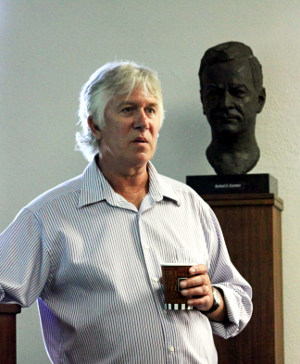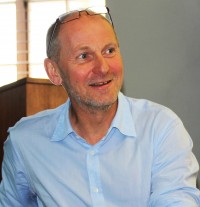
Mike Harrison, Americas Regional Director, led the discussions of ILC implementation planning. In the background is a bust of Richard Feynman, illustrious Caltech physicist. Image: GDE
The GDE Executive Committee held an important face-to-face meeting at Caltech in the US from 19 – 20 July 2011. Having established the new baseline for the ILC Technical Design Report (TDR) this past spring, the meeting concentrated on detailed planning for R&D, design and the actual scope and content of the report, which is planned to be completed at the end of 2012. Of particular note at this meeting were discussions of the first drafts of the TDR section on implementation planning. The meeting’s discussions ranged from planning for technical baseline reviews of final subsystem accelerator designs to worldwide industrialisation of the superconducting radiofrequency components.
The GDE Executive Committee (EC) is a group of the senior leadership of the GDE that meets weekly by teleconference to review and plan all aspects of our activities, to make top-level decisions, to organise meetings, and is generally the engine that runs the GDE. I chair the EC meetings in which I ask for reports, promote discussion and ask advice on the wide range of activities of the GDE. The EC has been invaluable to me and very effective, even though it primarily meets via cyberspace. However, even with the advances in conducting web-based long-distance meetings, we still find it necessary to have regular face-to-face meetings. We meet together during major ILC workshops two or three times per year, and in addition we schedule dedicated face-to-face meetings between these workshops.

An example of a possible schedule from the draft version of the Project Implementation Plan that could apply to many sites
The meeting in Pasadena came at a particularly crucial time, because after two years of intense concentration, we have established the baseline for the ILC technical design, our major goal as a GDE deliverable. The new baseline involves a set of four major changes from the reference design produced in 2007, plus many smaller changes. Planning for pulling this all together into a coherent design and presenting it in a TDR was the principal theme of the Caltech EC meeting.

Steiner Stapnes, Compact Linear Collider Study Leader, reported on both the CLIC plans and CERN perspectives to the EC at Caltech. Image: GDE
Much of the TDR will consist of an update of material presented in our earlier Reference Design Report, and there will be some important additions. In particular, especially within the EC, we have been discussing a wide range of issues related to how the ILC should be successfully implemented.
In many ways, the ILC represents new challenges in how to organise and manage a very large project, because of its inherent global nature. In the design stages, we have been able to carry out a successful R&D and design programme such that we have globally set priorities, organised the work and made decisions. How to maintain this global underpinning, once the ILC evolves into a construction project, presents new challenges. Hence, we have taken on areas of implementation planning in order that our understanding of these issues can be taken into account in the technical design we present, and so that we can help document the insights we have gained as to how the global ILC project should be implemented.
The Project Implementation Planning (PIP) section of the TDR was a major subject of discussion at the Caltech EC meeting. This part of the TDR will contain of sections on governance (a subject we have been working on for some time and have already documented). Other subsections will discuss: funding models; project management; host responsibilities; siting issues; in-kind contribution models; industrialisation and mass production of superconducting radiofrequency linac components; project schedule; and future technical activities. Mike Harrison is leading the PIP efforts. Although there is little precedent for including such a section in a technical proposal, we believe this section will contain valuable information on many of the issues that will confront the ILC, once it becomes a real project. Once the draft version of this section becomes more mature, we will begin to circulate it for comments.


Recent Comments